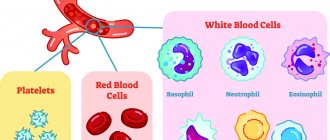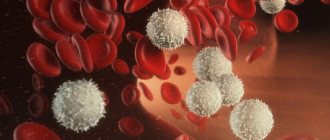Indications for analysis
MCV blood test is not the only one. To clarify the diagnosis, the therapist may require a retake or refer it for additional tests.
MCV is informative in two cases:
- in order to diagnose one of the types of anemia;
- to determine the type of water-salt imbalance. People are often sent for such an analysis if they have various intestinal infections, acute respiratory diseases and ARVI.
Other, no less serious, reasons for getting tested may be:
- failure of the hormonal system;
- metabolic problems;
- overweight;
- increased blood sugar or diabetes;
- a sharp and causeless decrease in the level of the immune system.
MCV analysis results often help identify such deviations:
- anemia of normochromic type. It is fixed when pathologies appear in the bone marrow, sometimes caused by chronic diseases;
- macrocytic type anemia. It is characterized by an excessive increase in mcv. Red blood cells increase in size due to insufficient amounts of vitamin B and folic acid;
- microcytic anemia. In this case, the disease occurs due to a lack of iron in the blood.
Increased value
If the average volume of red blood cells is increased, this may mean a disruption in the body’s functioning. Reasons when mcv is elevated can be:
- Liver disease.
- defect in the functioning of the red bone marrow.
- The thyroid gland does not produce enough hormones
- Vitamin B12 deficiency. This deficiency has a particularly negative effect on children under 2 years of age. At this age, you need to focus on eating foods containing high amounts of vitamin B12, for example, sour cream, eggs, liver, beef and others.
- Folic acid deficiency.
- Smoking. Smoking releases a significant amount of carbon dioxide, which impairs blood transport in the body, leading to a deterioration in oxygen supply. Women who smoke are more susceptible to respiratory diseases, which can cause increased red blood cell counts.
- Oncological diseases.
- Taking contraceptive and hormonal medications.
- Inflammatory processes in the body. These can be infectious diseases caused by a virus or some kind of fungus.
- Alcoholism. In this case, the mcv indicator can be brought back to normal; to do this, it is enough not to drink alcohol for 100 days. It is worth saying that in this case only mcv values increase, and the hemoglobin value remains within normal limits.
There is a version that taking antidepressants for a long time can lead to increased levels, but at the moment this version is under study.
An increase in red blood cells in the blood may be temporary and not carry any abnormalities or pathologies. This situation can lead to:
- stress,
- being in high mountains,
- excessive mental or physical work,
- influence of toxins,
- dehydration.
After these factors are eliminated, such important indicators of red blood cells as their average volume will return to normal.
(
1 ratings, average: 5.00 out of 5)
Normal MCV values
| Age, gender | Mean erythrocyte volume, MCV, fl | |
| Children | ||
| 1 day - 14 days | 88,0 — 140,0 | |
| 14 days - 4.3 weeks | 91,0 — 112,0 | |
| 4.3 weeks - 8.6 weeks | 84,0 — 106,0 | |
| 8.6 weeks - 4 months | 76,0 — 97,0 | |
| 4 months – 6 months | 68,0 — 85,0 | |
| 6 months – 9 months | 70,0 — 85,0 | |
| 9 months - 12 months | 71,0 — 84,0 | |
| 12 months - 5 years | 73,0 — 85,0 | |
| 5 years - 10 years | 75,0 — 87,0 | |
| 10 years - 12 years | 76,0 — 90,0 | |
| 12 years - 15 years | Women | 73,0 — 95,0 |
| Men | 77,0 — 94,0 | |
| 15 years - 18 years | Women | 78,0 — 98,0 |
| Men | 79,0 — 95,0 | |
| 18 years - 45 years | Women | 81,0 — 100,0 |
| Men | 80,0 — 99,0 | |
| 45 years - 65 years | Women | 81,0 — 101,0 |
| Men | 81,0 — 101,0 | |
| 65 years - 120 years | Women | 81,0 — 102,0 |
| Men | 83,0 — 103,0 | |
In children under 10 years of age, the index may fluctuate and be inaccurate; later it returns to normal (80-100 fl).
Study
The number of red blood cells is determined by a complete blood test.
Often in the result form you can find a line mcv with some numerical indicator, which means the average number of red blood cells. The name MCV comes from the English mean corpuscular volume, and the unit of measurement is usually considered to be a cubic micrometer or in fl - femtoliter. To calculate, take the average volume of red blood cells (ESR), which is then divided by the sum of the volumes of red blood cells in a portion of blood by their number in a given portion.
In the case where the average volume of red blood cells is reduced, a number of additional, more highly specialized studies are carried out to find out what this means and what deviations could lead to this.
Currently, there are additional tests when the mcv value in the blood decreases. These include the average hemoglobin content in a red blood cell, the values of which vary depending on the age of the patient and are absolutely independent of his gender. The size and color of blood cells are also analyzed for the volume of blood being tested.
Red blood cell indicators are:
- increased value, then this is called macrocytosis (100 or more) - red blood cells are larger than necessary,
- normal value – normocytosis (80-100),
- low value – microcytosis (80 or less).
The average volume of red blood cells in the blood varies depending on the patient's age. So, for example, for a newborn it is 95-121 fl, and already on the 14-30th day of life it is 88-124 fl. Children aged 1-5 years should have 73-85 fl, and for an adult 20-65 the norm is 80-100 fl.
MCV is higher than normal
If the results are above normal, this indicates the development of macrocytic anemia. It can be directly related to diseases such as:
- drug intoxication;
- food poisoning;
- problems with the thyroid gland;
- lack of iodine or iron in the body;
- liver dysfunction;
- oncological process of red bone marrow;
- long-term alcoholism;
- disruption of the pancreas.
An increase in mcv can be caused by:
- long-term use of birth control pills that affect hormonal levels;
- addiction to cigarettes and tobacco products;
- prolonged contact with toxic substances (work in hazardous industries);
- taking medications that increase the level of mcv in the blood.
If left untreated, macrocytic anemia can lead to frequent fainting, poor health, and low hemoglobin levels in the blood. Particularly at risk are:
- people who eat poorly, lead a sedentary lifestyle and ignore exercise;
- patients with chronic liver failure;
- people with a genetic predisposition to the disease;
- men over fifty-five years of age who abuse alcohol.
Experts identify some signs by which one can understand that a person’s red blood cell volume is too high:
- unhealthy pale lips;
- abdominal pain for no particular reason, which appears very often;
- the presence of tachycardia (heartbeat too fast), even when the person is at rest;
- skin with a yellowish tint.
If you notice similar symptoms or detect an increased level of mcv in the blood, you must immediately consult a general practitioner for appropriate treatment.
Why is MCV lowered?
If the MCV indicator in a blood test is low (does not reach the required 80 fl), most often this indicates that the child or adult is developing some form of anemia, that is, a lack of hemoglobin in red blood cells. Thanks to the compensatory properties of blood, the number of red blood cells themselves can increase, but all of them will poorly supply oxygen to the tissues and organs of a sick person.
The reasons for the decrease in the average volume of red blood cells may be the following conditions and pathologies:
- Iron deficiency anemia (grade 2-3) is a lack of iron, which the body receives from food or in the form of vitamin-mineral complexes. Often develops against the background of gastrointestinal diseases and microelement absorption disorders, intestinal tumors, gastritis with low acidity. Pregnancy can also lead to iron deficiency.
- Lack of folic acid, often also associated with pregnancy.
- Chronic diseases associated with constant blood loss: hemorrhoids, nosebleeds, peptic ulcers, etc.
- If the indicator in women is below normal, this may indicate the development of uterine tumors (fibroids, fibroids, or malignant ones). These diseases are characterized by frequent bleeding not associated with menstruation.
- A pathology of the red bone marrow that results in insufficient production of normal blood cells (congenital sideroblastic anemia). In addition to the congenital form, the disease can develop due to lead poisoning and taking a number of medications.
- Thalassemia, hemoglobinopathy and other hereditary blood diseases. Characterized by a decrease in the average size of red blood cells to 65 fl.
- Hemolytic anemia associated with increased destruction of blood cells (transfusion of blood incompatible with the patient’s group or rhesus, hereditary forms, disseminated intravascular coagulation syndrome).
Important information: What is the leukocyte blood count and what is it needed for (table of decoding norms for adults)
When the MCV value in the blood is below normal, but no pathologies are detected, the cause may be conditions associated with blood loss in large quantities:
- surgical intervention;
- trauma with injury to soft tissues and blood vessels;
- donation
Often, a decrease in the volume of red blood cells is also caused by metabolic disorders or endocrinological disorders (increased thyroid function, etc.). These conditions are distinguished from anemia by the normal hemoglobin content. Only a doctor can correctly decipher a blood test and determine the presence of any abnormality.
If you find a reduced reading of the average volume of red blood cells, it is recommended to visit a physician, especially if you have painful symptoms.
MCV below normal
Tests showing that the volume of red blood cells is below normal also indicates pathology. Experts name a number of reasons that can lead to such results:
- genetic predisposition;
- insufficient amount of water consumed;
- development of various types of anemia;
- lead intoxication;
- the presence of malignant formations, tumors in the body;
- taking medications that affect test results.
In medical circles, a disease in which the level of red blood cells in the body decreases is commonly called microcytic anemia. The peculiarity of the disease is that red blood cells do not perform their transport function, i.e. they do not deliver oxygen and other useful substances to the body’s cells in the required quantities.
With this pathology, a characteristic clinical picture is observed:
- constant fatigue;
- increased irritability, nervousness;
- decreased concentration and performance;
- absent-mindedness;
- memory impairment.
A decrease in the volume of red blood cells is always observed with various types of blood loss.
Pregnancy and mcv
During pregnancy, due to the body's increased consumption of iron, microcytic anemia can develop. This condition can negatively affect both the health of the unborn child and the well-being of the mother.
Some experts are convinced that mcv indicators are directly related to a person’s psychological state.
MCV blood test interpretation
The normal mcv value for people from 18 to 45 years old is considered to be in the range from 84 to 99 µm3. The mcv rate changes quite a lot over the course of a person’s life. For newborns, up to 112 µm3 is considered normal, then, as they grow older, the average volume of red blood cells quickly decreases. Therefore, already for teenagers 12-15 years old, the range from 73 to 95 cubic micrometers is considered normal.
In general, it can be said that the volume of red blood cells is maximum in newborns and decreases slowly throughout life. Moreover, the fact that most red blood cells have a normal volume does not exclude the presence of pathologies associated with the hematopoietic system. For example, normocytic anemias are quite common - blood diseases that do not affect the average volume of red blood cells.
Most often, such anemia occurs after serious blood loss, during the process of recovery from conditions associated with iron deficiency. Often normocytic anemia indicates suppression of the functions of the red bone marrow, severe liver and kidney diseases. Less commonly, it is a manifestation of other pathological processes, such as hemoglobinopathy. But do not confuse MCV and MCHC, as these are two different indicators.
Features of the analysis
Today, the mcv test is included in the general blood test or can be performed separately from other indicators. To donate blood, the patient must come to the treatment room, where a laboratory technician or nurse will take blood samples from a finger or vein. Blood sampling is carried out in accordance with all sanitary and epidemiological regulations (SanPiN).
The patient is required to comply with the following rules:
- You need to donate blood on an empty stomach (5-12 hours after your last meal);
- at the time of donation, the woman should not be menstruating;
- feeling normal. It is prohibited to take blood samples if the patient is not feeling well, is in a coma or is in cardiac shock.










